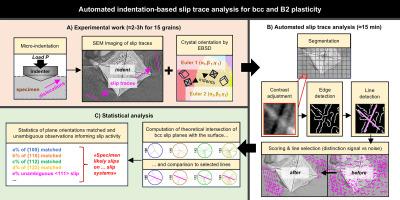Automated indentation-based slip trace analysis for bcc and B2 intermetallic plasticity
IF 5.5
2区 材料科学
Q1 MATERIALS SCIENCE, CHARACTERIZATION & TESTING
引用次数: 0
Abstract
Intermetallics are a key material class toward high-temperature applications, as monolithic materials such as B2 NiAl, or when used as a precipitate reinforcing phase within Ni fcc-superalloys or nascent bcc-superalloys and refractory high entropy superalloys. There is large variability across B2 ordered-bcc intermetallic compounds in terms of strength and ductility, which is underpinned by variability in their dominant slip systems. Here we have developed an automated indentation-based slip trace analysis method, designed to accelerate the assessment and quantification of favoured slip systems. The methodology uses microhardness indentation and imaging of the resultant surface slip traces, paired with local crystal orientations determined by Electron Backscatter Diffraction (EBSD). Our newly developed code for automated detection of slip trace orientations then uses image segmentation, Hough transform line detection, and a scoring procedure that evaluates how likely detected lines are to be aligned with real slip traces. This simply applied methodology is validated on fcc nickel, and then used to determine the slip behaviours of four bcc/B2 materials, finding unambiguous evidence of ½<111> {112} and/or {123} type slip in bcc Fe and B2 Ti2AlNb, compared to slip predominantly on {110} in B2 TiFe and Ti2AlMo, which correlates to their respective apparent ductile/brittle behaviours. The methodology can readily be adapted to other testing techniques (e.g. nanoindentation, tensile), and to gain deformation behaviour insights for other crystal structures (e.g. hcp and complex intermetallics).

bcc和B2金属间化合物塑性的自动压痕滑移轨迹分析
金属间化合物是高温应用的关键材料类别,作为整体材料,如B2 NiAl,或用作Ni fcc-高温合金或新生bcc-高温合金和难熔高熵高温合金中的沉淀增强相。B2有序-bcc金属间化合物在强度和延展性方面存在很大的可变性,这是由其主导滑移系统的可变性所支撑的。在这里,我们开发了一种基于压痕的自动滑动轨迹分析方法,旨在加速对有利滑动系统的评估和量化。该方法使用显微硬度压痕和由此产生的表面滑移迹的成像,并与电子后向散射衍射(EBSD)确定的局部晶体取向配对。我们新开发的自动检测滑动轨迹方向的代码随后使用图像分割、霍夫变换线检测和评分程序来评估检测到的线与真实滑动轨迹对齐的可能性。这种简单的应用方法在fcc镍上进行了验证,然后用于确定四种bcc/B2材料的滑移行为,发现bcc Fe和B2 Ti2AlNb中存在½<;111>;{112}和/或{123}型滑移的明确证据,而B2 TiFe和Ti2AlMo中主要存在{110}型滑移,这与它们各自的表观韧性/脆性行为相关。该方法可以很容易地适用于其他测试技术(例如纳米压痕,拉伸),并获得其他晶体结构(例如hcp和复杂金属间化合物)的变形行为见解。
本文章由计算机程序翻译,如有差异,请以英文原文为准。
求助全文
约1分钟内获得全文
求助全文
来源期刊

Materials Characterization
工程技术-材料科学:表征与测试
CiteScore
7.60
自引率
8.50%
发文量
746
审稿时长
36 days
期刊介绍:
Materials Characterization features original articles and state-of-the-art reviews on theoretical and practical aspects of the structure and behaviour of materials.
The Journal focuses on all characterization techniques, including all forms of microscopy (light, electron, acoustic, etc.,) and analysis (especially microanalysis and surface analytical techniques). Developments in both this wide range of techniques and their application to the quantification of the microstructure of materials are essential facets of the Journal.
The Journal provides the Materials Scientist/Engineer with up-to-date information on many types of materials with an underlying theme of explaining the behavior of materials using novel approaches. Materials covered by the journal include:
Metals & Alloys
Ceramics
Nanomaterials
Biomedical materials
Optical materials
Composites
Natural Materials.
 求助内容:
求助内容: 应助结果提醒方式:
应助结果提醒方式:


